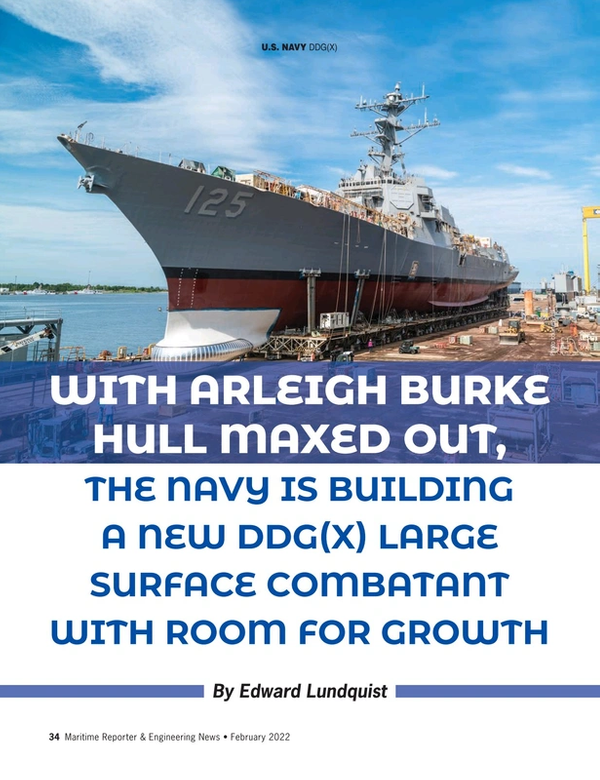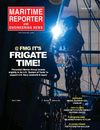
Shipbuilding: Fincantieri Marine Group Invests Mightily to Deliver for the US Navy
When he served as the commander of NWSC Carderock, Mark Vandroff woke every morning knowing that his counterpart in China had just gone to bed and had spent that day trying to make China’s Navy superior. His job, he figured, was to “get cracking and work to make our Navy even better.” Now the CEO at Fincantieri Marinette Marine (FMM), Vandroff brings that passion for navy shipbuilding – and delivering on the new USN Constellation-class frigates contract – to work every day.
Introducing a new class of warship usually comes with a heaping helping of pain, from cost overruns to technical glitches. Serving as the prime contractor on the first two Constellation-class guided missile frigates (FFGs), Fincantieri Marinette Marine (FMM), Marinette, Wisc., and its parent company Fincantieri Marine Group (FMG) are investing mightily in the shipyard – technology, people and processes – to help mitigate risk as prudently as possible in delivering for the U.S. Navy.
To reduce risk to budget and schedule, the new FFG will be built on an existing hull design and armed with well-known combat systems and weapons. The current program of record is for 20 ships, although it could be more. FMM has been awarded a detail design and construction (DD&C) for up to 10 ships in the program — the lead two ships plus eight option ships, to date.
“The program was assigned to us at the beginning of 2020,” said Dario Deste, CEO & President, FMG. “The program itself is for 10 ships. We received the first one for about $800 million and we received the second one in May 2021.” Deste, a former Italian Naval pilot who has been in shipbuilding for about 15 years, said his experience as a pilot taught him to always think ahead, a valuable tool in shipbuilding to help anticipate and head-off problems while they are small. “When you’re flying a plane, you cannot stop the plane and say, ‘Let me think where I’m going, what I’m doing.’ You have to constantly think ahead.”
As the prime contractor on this new class of U.S. Navy ship, Deste and his team are working relentlessly to deliver as expected. “We have a lot of challenges here, but I would say the first priority for us is to execute the program and be on schedule,” said Deste. “Being on schedule is imperative, and it’s something that I make clear to all of my teammates through the organization.”
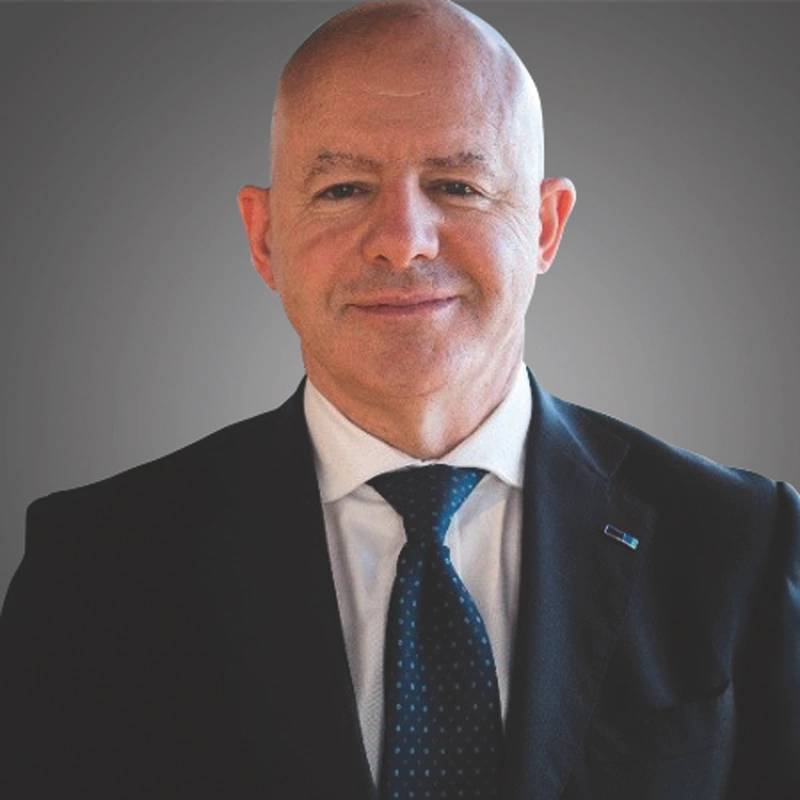 “One of the things that has been very useful for me is to think ahead. When you’re flying a plane, you cannot stop the plane and say, "Let me think where I'm going, what I'm doing." You have to constantly think ahead. It's very much the same in business, especially in shipbuilding.” Dario Deste, CEO & President, Fincantieri Marine Group, discussing the skillsets of being a former Navy pilot that translate into shipbuilding leadership. Photo courtesy FMG
“One of the things that has been very useful for me is to think ahead. When you’re flying a plane, you cannot stop the plane and say, "Let me think where I'm going, what I'm doing." You have to constantly think ahead. It's very much the same in business, especially in shipbuilding.” Dario Deste, CEO & President, Fincantieri Marine Group, discussing the skillsets of being a former Navy pilot that translate into shipbuilding leadership. Photo courtesy FMG
Risk Mitigation, by Design
While investment by FMG has been substantial and continual, arguably the first, best step to help ensure the first two contracted ships are designed and built with minimal hitches lay in the selection of an existing, lower-risk design for the ship.
FFG 62 is based upon a “parent design,” the Italian-French FREMM (Fregata Europea Multi-Missione) frigate, a ship that is being been built in France and Italy for their respective navies and a few foreign customers. FMM’s parent company, Fincantieri builds the ships at its Muggiano shipyard at La Spezia, Italy. Although the parent design is European, FFG 62 will have significant American content, to include a government furnished combat system centered around the new SPY 6 radar and newest baseline of the Aegis Combat System and other U.S. sensors and systems.
The American version will be about 23 feet longer and about 500 tons heavier to provide margin for growth and to accommodate future weapons such as lasers, although the bridge and propulsion plant layout is the same. It will be equipped with a 32-cell, strike-length MK 41 vertical launch system (VLS) launcher and armed with Standard Missiles, Naval Strike Missile capable and Evolved SeaSparrow Missile (ESSM) Block II; a Mk110 57mm main gun, and have the RAM close-in system for point defense. It will have a flight deck and hangar for MH-60R helicopters. It will have essentially the same anti-air and anti-submarine warfare capability as the newest Flight III DDGs.
“It is a risk reducer,” said Mark Vandroff, CEO, FMM, in discussing the pros and cons of the parent design, but using the European design is not without challenges. Premised on the ‘Buy American Act’, the new U.S. Navy FFG will have an entirely new set of equipment manufactured in the United States. With that, “you’re going to have some significant level of design work in order to accommodate the difference in equipment,” said Vandroff.
He points out another critical difference: getting the parent design to meet U.S. Navy damage control and survivability standards.
“Having been the CEO of Carderock, I was involved in an organization that helped develop and maintain those standards, so, I’m very familiar with them,” said Vandroff. “The way we compartment ships, the way we build in redundancy and separation of vital systems is unlike any other Navy or commercial enterprise in the world.”
The engineering work that goes into meeting and beating the U.S. Navy standards is no small feat, and while he knows his team is up to the challenge, the process does not come without those moments when you ask: “Well, how the heck are we going to make this work?”
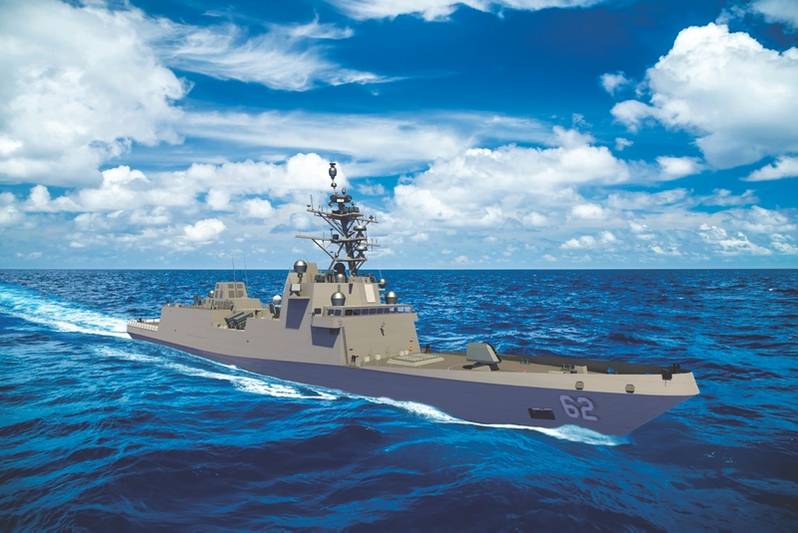 FFG-62 rendering. Photo courtesy FMG
FFG-62 rendering. Photo courtesy FMG
Investing in the Shipyard(s)
Serving as the prime contractor on a new U.S. Navy shipbuilding contract comes with ample challenges and rewards, too. According to Deste, the three basic essentials to have an efficient shipbuilding system is to have a very high-technology products and systems; the facilities and the people. “Those are the three main pillars to good steady operations.”
While the FFG is the current focus, FMG’s investment in FMM started before construction began on the Littoral Combat Ship program, an investment of around $150m to “get the shipyard up to speed.”
But to win the frigate contract, more investment was needed. “The Navy was very clear about our capacity. We had to produce two ships per year at least, so we redesigned the shipyard,” said Deste. The end result when completed will be an ultra-modern and efficient layout, a layout that “will allow us to complete up to 92% of the ship before it’s in the water.”
All told, FMM will have invested $300 million in capital expansions to prepare for the U.S. Navy frigate contract, $300m invested in a contract that could be worth $5.5 billion if all options are exercised.
The major pieces of the capital investment strategy include:
- Panel Line: FMM is getting a new robotic panel line, module assembly facility and paint shop. Bay Shipbuilding in Sturgeon Bay, a commercial yard that will support the frigate contact, is undergoing similar upgrades. “We had a great panel line facility at Marinette for the LCS program, but for the frigate program we’ve invested in state-of-the-art technology,” said Vandroff. “What we used to do with about 12 people will now be done with one or two operators. The robotic welding gives a more consistent, higher quality product, as well as the ability to put more panels through the line more efficiently. That new panel line is installed and going through its final testing.” With the previous system, when panels came off of the line they were shuttled around the yard for module assembly. At the end of the new line is a new module assembly facility. “This way, we’re moving more complete modules around the yard for outfitting, and that’ll be a more efficient flow for the frigate throughout the yard,” said Vandroff.
- Building 34: Wisconsin winters are harsh, so keeping as much construction under cover in a climate-controlled environment positively impacts efficiency. To this end Building 34 will accommodate the construction and erection of two full-size frigates simultaneously under cover. The frigate is both longer, taller and heavier than the littoral combat ships that FMM is now building, and it needed a larger facility. FMM broke ground on the building at the beginning of 2020, and “I would describe it as dangerously near completion,” said Vandroff, noting that the contractor should be done with a few final items, in time for a ribbon-cutting in March/April 2022.
- Ship Lift: The other major investment is the installation of a Syncrolift, which will allow FMM to lower ships into the water more gently and effectively than the traditional side launch into the Menominee River. “Ships have been side launched for a long time: it’s simple, it’s not a lot of infrastructure. You just need a set of incline weights and you let gravity take its natural course,” said Vandroff. “But there are some drawbacks.” First, the yard can complete more of the ship on land using the ship lift. “And there are some things that are on the frigate that we don’t want a side launch, parts of the combat system that require very high precision alignment. We want to do that in the building, and then we don’t want do it again after we put it in the water.” With most of the ship lift’s civil works done, it is expected to be up and operational by the end of 2022, in time to launch the first of four multi-mission surface combatant hulls, similar to the LCS design, for the Royal Saudi Navy. When completed, the new ship lift system will be approximately 500 ft. long and 82 ft. wide, and will be capable of handling vessels of nearly 10,000 tons, making it the largest in the U.S.
- Blast and Paint Facility: In moving the panel line, FMM freed up a production building which will be converted to an additional blast and paint facility. “We have excellent blast and paint facilities in the yard,” said Vandroff. “But if we’re going to do two frigates a year, which is the Navy’s goal for us, we needed additional blast and paint capacity. That conversion project is scheduled for completion in 2023.
While much of the focus, rightfully so, is on FMM, two additional FMG shipyards in the area – Fincantieri Bay Shipbuilding in Sturgeon Bay, which is a commercial yard; and Fincantieri Ace Marine in Green Bay, which builds aluminum boats up to 25m long, as well as aluminum modules – complete Fincantieri’s ‘system of yards’ that provide flexible manpower and facilities to help facilitate the building of the Frigates.
“For the frigate, Bay is going to be critical for us,” said Vandroff. “We’ve invested significantly in Bay: a new panel line, a new blast and paint facility, and a new erection bay. Roughly one-fourth of the frigate will be built in Bay and completely erected and outfitted and then barged over for those super modules to be erected onto the ship. And that gives us a lot of advantages, particularly in terms of workforce flexibility.”
“Shipyards are most efficient when they are busy, working at capacity,” added Deste. And while each of the three yards will contribute to the Navy program, he was quick to emphasize: “Let me be crystal clear here; commercial shipbuilding and repair will remain the core business at Bay Shipbuilding.”

“Tiger Woods once said his golf swing was never standing still. He was either working to get it better or it was getting worse. I have that same philosophy about safety. You’re either working to make it better or over time, it will start to get worse.”
Mark Vandroff, CEO, Fincantieri Marinette Marine. Photo courtesy FMM
People, too
In addition to the physical facilities, FMM is laser focused on growing its employee base to deliver on its military contracts. “The biggest long-term risk for our ability to execute this program is manpower,” said Vandroff. “Right now, we’re roughly 1,000 trade workers in the yard, and I need to grow that to about 1,400 over the next two years. And I probably need to add around 100 additional white-collar employees between additional engineers and additional business professionals.”
To address the need FMM is attacking the issue on multiple fronts. “We are engaged in national recruiting efforts for both blue collar and white collar employees,” said Vandroff, as well as leveraging partnerships with the State of Wisconsin, as well as educational institutions from the local high schools to the local technical and community colleges, as well as the local four-year college, the University of Wisconsin-Green Bay. “Their Dean of Engineering and their Dean of their Business School have both visited the yard,” said Vandroff, and both have tailored curriculum so that their engineers and business professionals both have the skills that FMM needs. If all else fails, there is outsourcing. “On previous programs we’ve given chunks of ship construction to an outsource partner,” said Vandroff. “We are exploring options to do that, additionally, on the frigate in order (if needed) to make sure that we have the right resources to build the ships at the rate the Navy needs us to build them.
New Fincantieri Florida Ship Repair Business is ‘Open’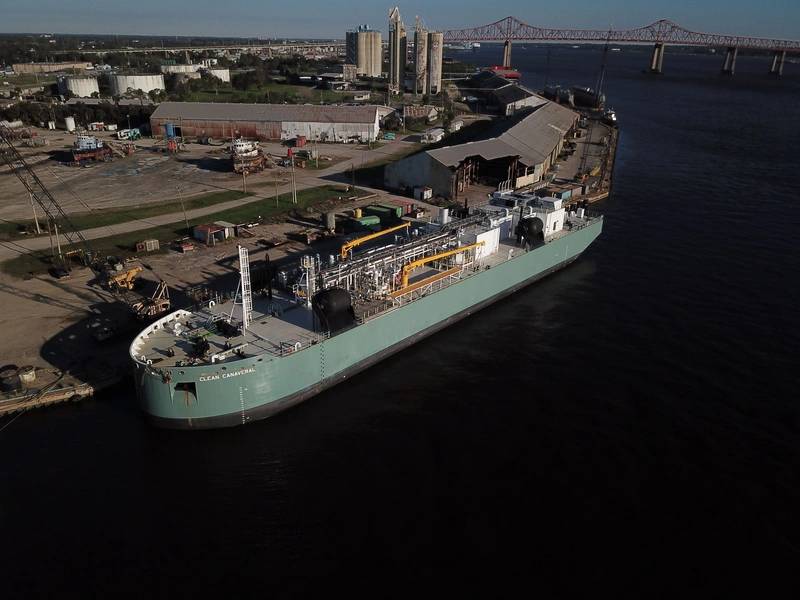 The first customer for the new Fincantieri Marine Repair facilities, Commodores Point, Jacksonville, Fla. repair yard is a commercial vessel, and one that has special meaning: it is the recently-competed liquefied natural gas (LNG) barge Clean Canaveral, which was built by Fincantieri Bay Shipbuilding in Sturgeon Bay, WI. Image courtesy Fincantieri Marine Group
The first customer for the new Fincantieri Marine Repair facilities, Commodores Point, Jacksonville, Fla. repair yard is a commercial vessel, and one that has special meaning: it is the recently-competed liquefied natural gas (LNG) barge Clean Canaveral, which was built by Fincantieri Bay Shipbuilding in Sturgeon Bay, WI. Image courtesy Fincantieri Marine Group
Prompted by the Navy’s request to expand its ship repair capacity and help enable a better record of uptime for navy ships, particularly the ones built by Fincantieri Marinette Marine, Fincantieri Marine Repair, a division of Fincantieri Marine Systems North America (FMSNA), expanded to Northeast Florida late in 2021, and in early January 2022 welcomed its first commercial customer to Commodores Point in downtown Jacksonville, effectively marking the start of operations in northeast Florida.“The U.S. Navy wanted additional maintenance and sustainment support for Fincantieri-built military ships homeported in nearby Mayport, and that’s what we’ve done,” said Dario Deste, CEO & President, Fincantieri Marine Group. “But there are other military, government and commercial customers who need sustainment help as well, especially in the southeastern U.S.”
According to Deste, the move to open the new facility and bring it up to ‘Fincantieri standards’ represents an investment of nearly $30 million – with the new 16,000-ton capacity drydock expected to open in early 2023, serving as the biggest ticket time – with additional investment to come.
Fincantieri Marine Group already has a well- and long-established repair hub in Wisconsin in the form or Bay Shipbuilding, but the Florida facility is well situated to handle both Littoral Combat Ships built by Fincantieri Marinette Marine as well as similarly sized military and commercial craft.
The ship repair practice is seen throughout the Fincantieri brand globally, particularly in the cruise and foreign military sectors, and as Deste reasons “we obviously know best what we build. To the navy, maintenance and sustainment is a serious issue,” said Deste. “We talk about increased number of ships, and that is obviously very important. But we also have to talk about how to keep those ships at sea as long as possible (with an efficient repair cycle). We don’t want to waste time (in the shipyard), we want to keep ships sailing; so it is important to have more quality facilities where the ships can be maintained and repaired as quickly as possible.”
For the navy, keeping ships in shape and sailing is a mission imperative for national security; for the commercial market, it’s a business imperative to keep cash flowing.
The first customer for the new repair yard is a commercial vessel, and one that has special meaning: it is the recently-competed liquefied natural gas (LNG) barge Clean Canaveral (pictured), which was built by Fincantieri Bay Shipbuilding in Sturgeon Bay, WI, and is in the yard for testing and trials.
Read Shipbuilding: Fincantieri Marine Group Invests Mightily to Deliver for the US Navy in Pdf, Flash or Html5 edition of February 2022 Maritime Reporter

